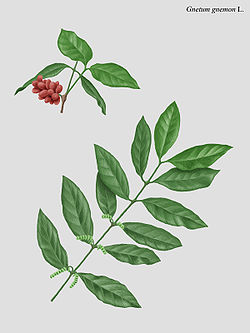Gnetophyte
- Gnetophyte
-
Gnetales
Les Gnetales est un ordre de plantes gnétophytes. Ce sont des plantes que l'on a longtemps considérées comme proches des plantes Angiospermes. On les estime plutôt proche des Gymnospermes à l'heure actuelle.
Classification
Selon les auteurs, la classification varie légèrement. Pour certains, l'ordre seulement le genre Gnetum, le genre Ephedra et le genre Welwitschia[1].
Pour d'autres, l'ordre ne contient que le genre Gnetum. Les genres Ephedra et Welwitschia sont alors placés dans deux ordres qui leur sont dédiés.
Références
Notes et références
 Portail de la botanique
Portail de la botanique
Wikimedia Foundation.
2010.
Contenu soumis à la licence CC-BY-SA. Source : Article Gnetophyte de Wikipédia en français (auteurs)
Regardez d'autres dictionnaires:
gnétophyte — ● gnétophyte nom féminin Plante gymnosperme vectrice très évoluée. (La classe des gnétophytes comprend trois ordres, actuellement très réduits : les gnétales, les éphédrales et les welwitschiales.) … Encyclopédie Universelle
gnetophyte — ▪ plant Introduction any member of the division Gnetophyta, a small group of gymnospermous vascular plants that are represented by three living genera: Ephedra, Gnetum, and Welwitschia. There are 65 species in the genus Ephedra, 30 or more… … Universalium
Gnétophyte — Gnetales Gnetales … Wikipédia en Français
Gnetaceae — ▪ gnetophyte family a family of tropical gymnosperms in the order Gnetales (division Gnetophyta), composed of one genus, Gnetum, with 30 or more species. Trees predominate among the African species; most of the Asian varieties are woody… … Universalium
Welwitschiaceae — ▪ gnetophyte family a family of southwestern African desert plants in the gymnosperm order Gnetales, named for its single genus, Welwitschia. tumboa plants (W. mirabilis), constituting the only species, have deep taproots and resemble giant … Universalium
gymnosperm — gymnospermism, n. /jim neuh sperrm /, n. Bot. a vascular plant having seeds that are not enclosed in an ovary; a conifer or cycad. Cf. angiosperm. [1820 30; < NL gymnospermae name of type. See GYMNO , SPERM] * * * Any woody plant that reproduces… … Universalium
plant — plantable, adj. plantless, adj. plantlike, adj. /plant, plahnt/, n. 1. any member of the kingdom Plantae, comprising multicellular organisms that typically produce their own food from inorganic matter by the process of photosynthesis and that… … Universalium
Gnetophyta — Taxobox name = Gnetophyta image width = 240px image caption = Welwitschia mirabilis regnum = Plantae divisio = Gnetophyta classis = Gnetopsida subdivision ranks = Genera subdivision = * Gnetum * Welwitschia * Ephedra The plant division Gnetophyta … Wikipedia
Gymnosperm — Taxobox name = Gymnosperms fossil range = fossil range|370|0Devonian Recent image width = 150px image caption = White Spruce leaves (needles) regnum = Plantae subdivision ranks = Divisions subdivision = Pinophyta (or Coniferophyta) Conifers… … Wikipedia
angiosperm — /an jee euh sperrm /, n. Bot. a plant having its seeds enclosed in an ovary; a flowering plant. Cf. gymnosperm. [ANGIO + SPERM] * * * ▪ plant Introduction any member of the more than 300,000 species of flowering plants (division Anthophyta) … Universalium


 Retrouvez ce taxon sur Wikispecies
Retrouvez ce taxon sur Wikispecies
